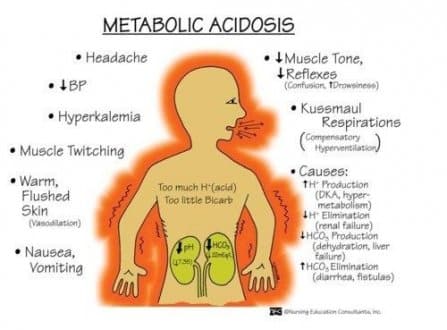Metabolic Acidosis is a condition characterized by an abnormally low pH in the bloodstream, indicating acidity. For the human body to function optimally, the blood pH must be maintained within a narrow range of 7.35 to 7.45. Any deviation from this range can have significant health implications.
What is Metabolic Acidosis?
Metabolic acidosis occurs when the body accumulates too many protons or loses too much bicarbonate, leading to a decrease in blood pH below 7.35. This condition can manifest due to various causes, including kidney issues, diabetes, or as a consequence of consuming certain medications.
Symptoms of Diabetic Ketoacidosis
Recognizing the signs and symptoms of metabolic acidosis is crucial, especially in individuals with risk factors like type 1 diabetes. Key symptoms include:
- Rapid, deep breathing: Often noticeable even at rest.
- Headache and confusion: These symptoms may occur especially if metabolic acidosis is severe.
- Increased heart rate: Notable even while resting.
- Extreme fatigue: More severe and sudden than typical tiredness.
- Digestive disturbances: This includes a lack of appetite, abdominal pain, nausea, and vomiting.
- Changes in physical appearance: Such as a flushed face, dry skin, and mouth, and a fruity breath smell due to ketone buildup.
These symptoms warrant immediate medical attention, particularly if they occur together.
Causes of Metabolic Acidosis
One of the primary risk factors for developing metabolic acidosis is type 1 diabetes, particularly when it leads to diabetic ketoacidosis (DKA). In type 1 diabetes, the absence of insulin production disrupts the normal transport of protons (H+ ions) and potassium into cells, contributing to acidosis and hyperkalemia (high potassium levels).
Other triggers include increased insulin needs during stress or infection, leading to an imbalance unless properly managed with insulin therapy.
Diagnosing Metabolic Acidosis
The diagnosis of metabolic acidosis, particularly diabetic ketoacidosis, often relies on clinical symptoms. However, laboratory tests are crucial to determine the severity:
- Adults: Mild DKA is indicated by a pH between 7.25 and 7.30, with serum bicarbonate levels of 15–18 mmol/L.
- Children: For those under 18, mild DKA presents with a pH of 7.20–7.30 and bicarbonate levels between 10–15 mmol/L.
Early diagnosis is vital to manage the condition effectively before it progresses to more severe stages.
Note it is most important to understand what classifies as “Mild DKA” criteria because it is still a medical emergency that requires immediate hospitalization, but it also catches the patient before ICU critical care is necessary.
Treatment of Metabolic Acidosis
Treatment for metabolic acidosis depends on the underlying cause but generally involves correcting the acid-base balance and treating any accompanying conditions. For diabetic ketoacidosis, this includes:
- Intravenous fluids to restore hydration and correct electrolyte imbalances.
- Insulin therapy to reduce blood sugar levels and correct metabolic abnormalities.
- Monitoring and adjustment of electrolytes like potassium and sodium.
Treatment typically requires intensive care with continuous monitoring of vital parameters to ensure recovery without complications. It also requires complex algorithms with close monitoring and care to prevent rapidly correcting glucose and electrolytes to normal values, which may cause permanent neurological damage. It is important that the patient does not fix “mild DKA” on their own, even if their family members are medical professionals. Households do not have the equipment necessary to resolve DKA safely.
Conclusion
Metabolic acidosis is a serious condition that requires prompt medical attention. Individuals, especially those with risk factors like diabetes, should be aware of the symptoms and or detect abnormal biochemical values such as high blood sugar with high ketones and seek immediate care if they suspect metabolic acidosis. Always consult healthcare professionals for accurate diagnosis and treatment plans.
Disclaimer: This article is for informational purposes only and does not constitute medical advice. Always seek professional medical advice for any health concerns.


